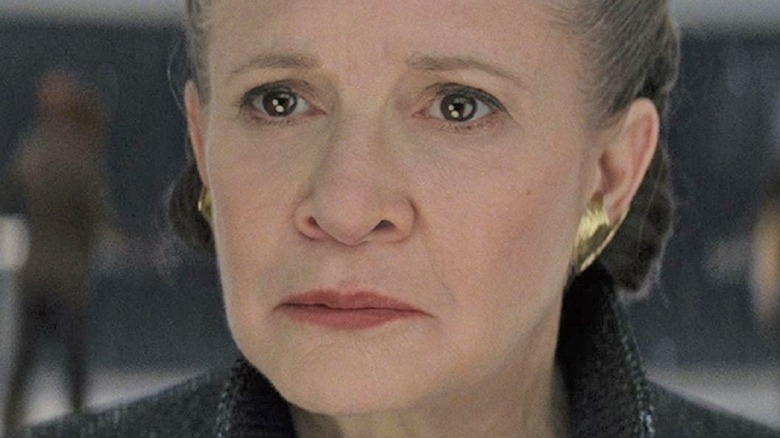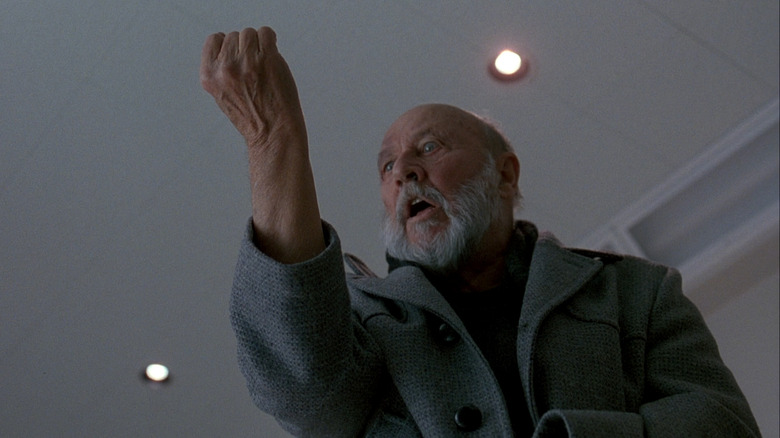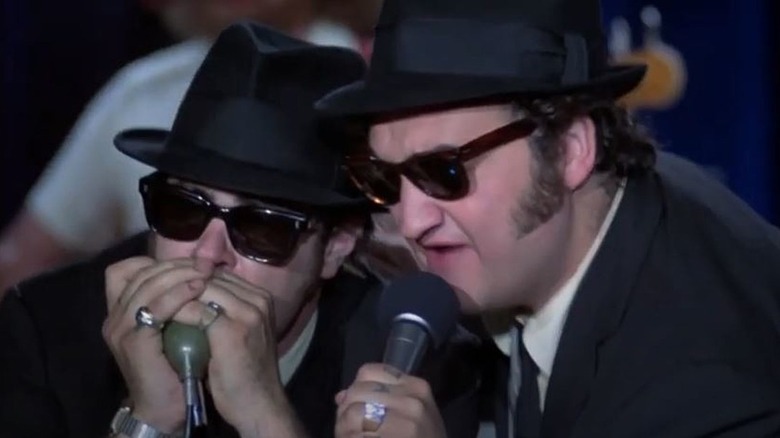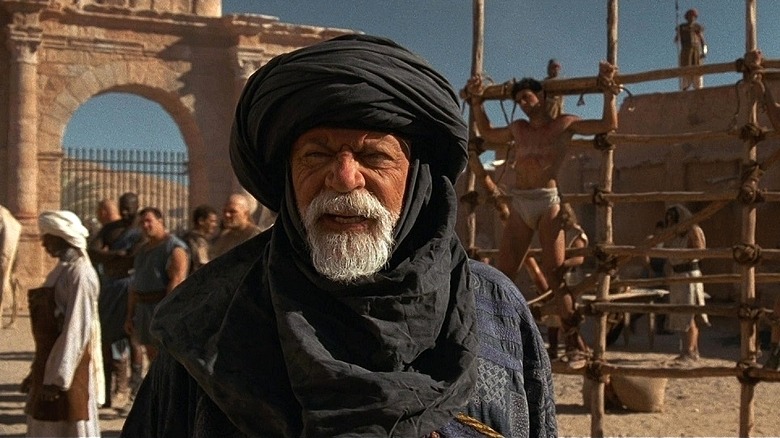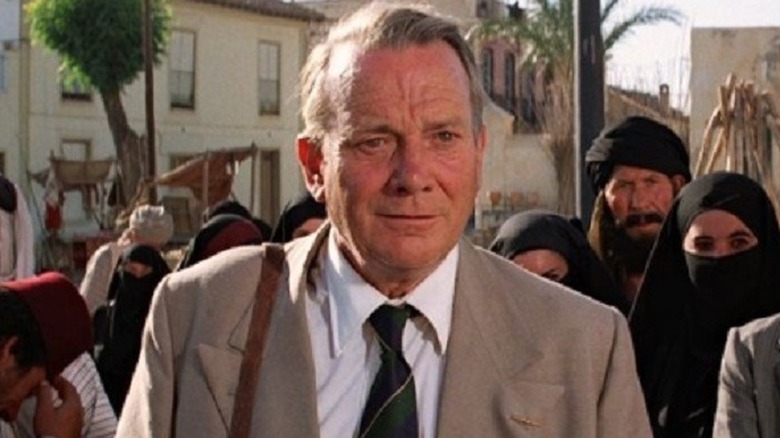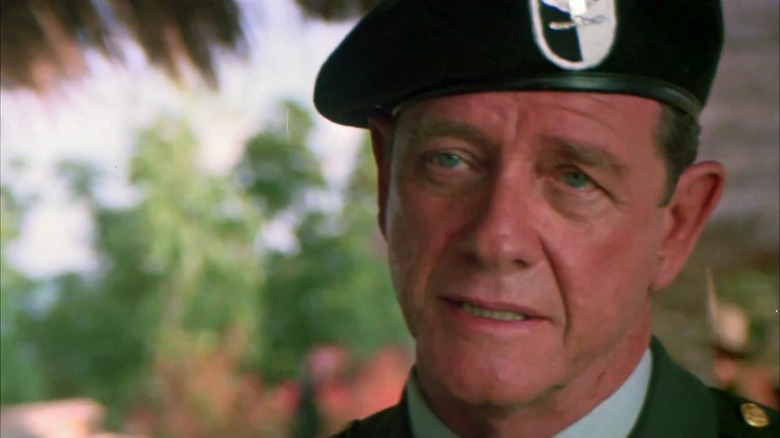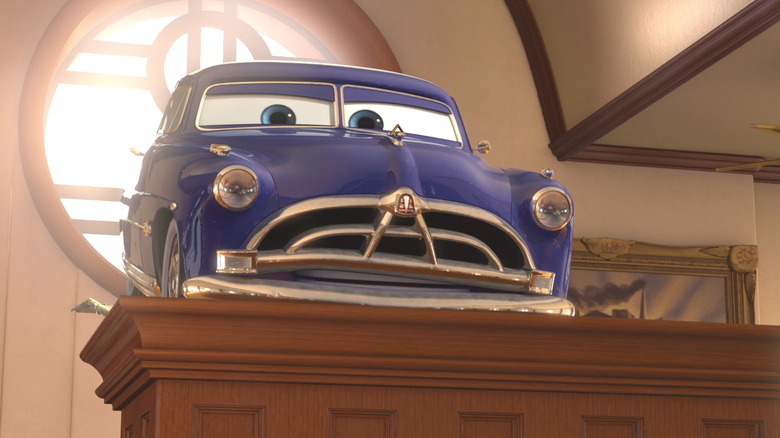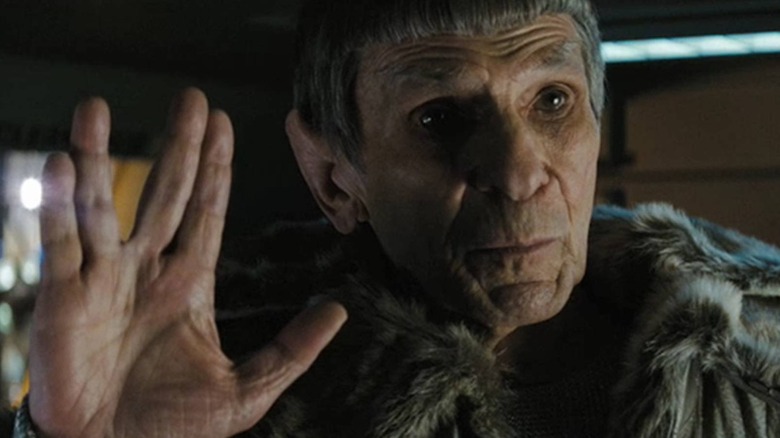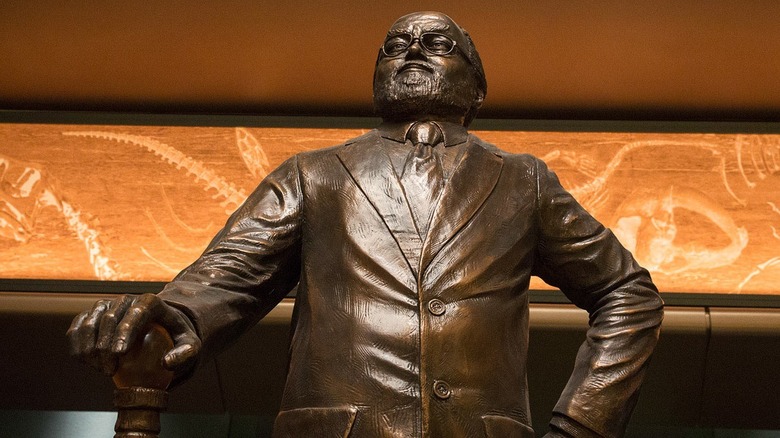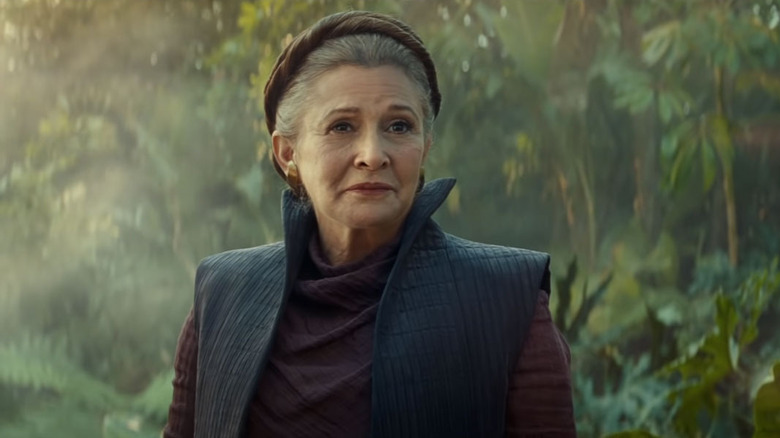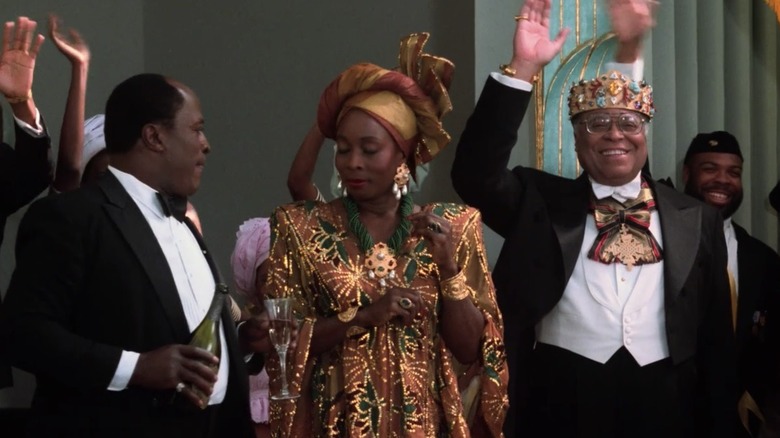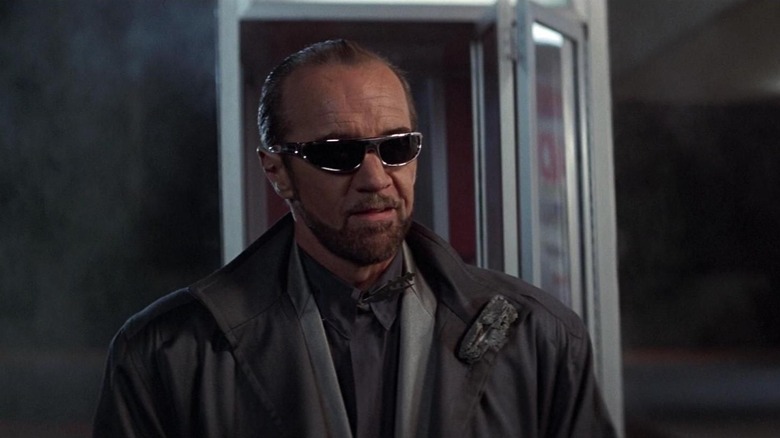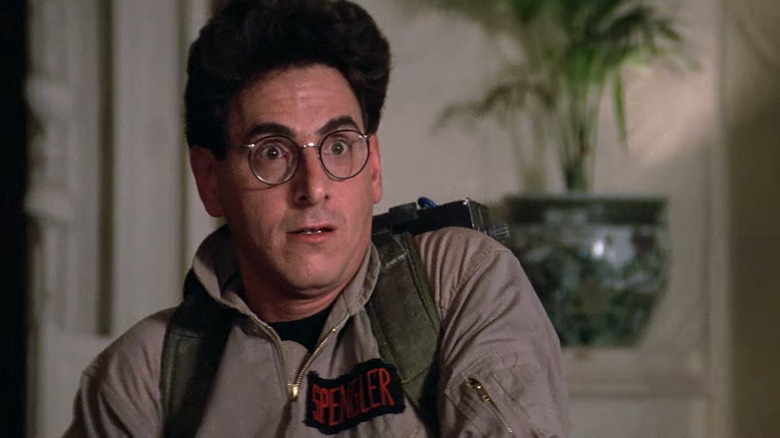Movie Deaths That Happened Because The Actor Died In Real Life
It takes a lot to make a stew, and it takes a lot of people to make a movie. But there's some disagreement about just how important each person is, especially the actors. Are they just interchangeable cogs, or does their work making fictional characters real mean those characters can't exist without them?
Different franchises answer this question in different ways. Some will pay millions of dollars to keep their biggest stars onboard. Others will happily cycle through multiple actors to fill roles like Tarzan, Sherlock Holmes, and James Bond. Sometimes, characters like Spider-Man and Batman can even be played by multiple actors at the same time.
And what happens when actors go to that place where no amount of money can bring them back? In the case of death, some franchises will keep plugging along with new stars. But in some cases, the character just doesn't exist without the actors, and pretending otherwise would be as disrespectful as dancing on their grave.
That was the case in all the movies below. Some handled an actor's death gracefully, with the grief in the fictional world paying tribute to the grief we experience in reality. Some tried their best to keep going over the finish line, even if it required expensive innovations in special effects. Others make us wonder whether the best tribute would've been to just let the franchise die. We'll let you decide which is which.
Halloween reshoots killed Dr. Loomis
Donald Pleasence was never an A-list star, but few actors were as huge in the sleazy underworld of low-budget genre fare as he was. Pleasence appeared in over 200 movies and TV shows over his almost half-century career, ranging from a turn as James Bond's nemesis Blofeld in "You Only Live Twice" to something called "Frankenstein's Great Aunt Tilly." But he finally got his moment in the spotlight in 1978 with "Halloween." That movie made him a horror icon as Dr. Sam Loomis, the psychologist who tracked serial killer Michael Myers across five movies, with his hoarse British voice lending gravitas to the doctor's warnings of doom.
When Pleasence died in 1995, he'd already filmed his final appearance as Loomis for "Halloween: The Curse of Michael Myers," which revealed Michael's murderous habits and apparent immortality were the result of the ancient "Curse of Thorn" that druids had placed on him. The original ending would've passed the curse on to Loomis, but the test audience wasn't having it, so the studio had to shoot a new ending without the late Pleasence. The version that reached theaters in 1995 was more in line with Pleasence's real-life fate. In the final scene, having apparently defeated Michael once again in an abandoned hospital, Loomis stays behind to clean up his mess. Then we hear a scream, implying Loomis met the same fate as Pleasence, even if it was of much less natural causes.
Jake and Curtis didn't return for Blues Brothers 2000
In "The Blues Brothers," John Belushi and Dan Aykroyd played Jake and Elwood Blues, who return from jail to drive across the country — with police in hot pursuit — to get their band back together and save the orphanage where they grew up from demolition. The movie also introduced their mentor, Curtis the janitor, who taught them everything they know. That's true in real life too, since he was played by legendary Depression-era jazzman Cab Calloway.
The brothers returned to the screen over 15 years later, but there were a few hitches. John Belushi's legendarily self-destructive rock star lifestyle caught up with him in 1982 when he overdosed on a fatal combination of cocaine and heroin. And of course, Calloway, who was already over 70 when he filmed the original "Blues Brothers" and died in 1994, wouldn't be back either. And "Blues Brothers 2000" doesn't dance around the elephant in the room. In the very first scene, Elwood is waiting for Jake to pick him up from prison when he learns his brother died. As if that wasn't enough of a kick in the teeth, Elwood returns to the orphanage to find out it was still demolished despite his efforts ... and Curtis is also dead.
John Goodman plays "Mighty" Mack McTeer, who takes Jake's role as lead singer and his iconic suit-and-sunglasses ensemble. But director John Landis apparently didn't think one Goodman could equal one Belushi, so he tried to balance the equation with even more replacement Blues Brothers, including a little orphan and Curtis' son, Cab (Joe Morton).
Oliver Reed's death led to a colossal change for Gladiator
"Gladiator" was even more old-fashioned than its 2nd-century setting might suggest. It was a throwback to the big-budget "sword-and-sandal" epics that dominated the box office of the '50s and '60s and the silent era before that. And its success brought the genre back from the dead, leading to a boom that culminated in the surprise blockbuster success of "300." And director Ridley Scott made a concrete link with his forebears by casting Oliver Reed, the star of mid-century period pieces like "Oliver!" and "The Devils" as Proximo, the owner/trainer of Russell Crowe's gladiatorial hero. Unfortunately, Reed loved drinking at least as much as acting. According to Nicole LaPorte's DreamWorks history "The Men Who Would Be King," a 12-double rum bender led Reed to two heart attacks, the second one fatal.
It's difficult enough to replace an actor for a sequel, but what do you do when they die mid-movie? Producer Walter F. Parkes says, "You take in the human loss, and then, much too quickly, the producer takes over and you say ... 'How much of this have we shot, and how are we going to deal with this?'" The answer involved a script rewrite to kill off Proximo partway through the movie. But since it was filmed out of sequence, there were still a lot of Proximo scenes to put together Reedlessly. Doing so required a special effects breakthrough, with other actors standing in for Reed and Ridley Scott's crew digitally replacing their faces.
Brody didn't appear in Kingdom of the Crystal Skull for a very sad reason
"Indiana Jones and the Kingdom of the Crystal Skull" brings Harrison Ford's adventurous archaeologist into the future ... a future that doesn't look too bright. The '50s Red Scare is making his job harder than ever, and his aging body isn't up to his old whip-swinging acrobatics. One scene reveals a more concrete loss to the passage of time, as Indy reflects on the death of his university colleague and occasional sidekick Marcus Brody.
We don't learn the in-story cause of his death, but if it's as sad as the real one, it's probably better not to burden the audience with it. Brody's actor, Denholm Elliott, was a victim of the '80s AIDS crisis, as the autoimmune disorder worsened a bout of tuberculosis to fatal proportions. He died in 1992, four years after his final appearance as Brody in "Indiana Jones and the Last Crusade."
That aforementioned "Crystal Skull" sequence also explains the absence of another character who would've been even closer to Indy — his father, Henry Jones Sr. He was played by Sean Connery, and while the James Bond star was still very much alive when "Crystal Skull" premiered in 2006, he'd retired from acting a few years earlier. He only came back for the low-budget Scottish cartoon "Sir Billi," but from what we've seen of it, he probably wished he hadn't.
Col. Trautman couldn't outlive the man who played him
Richard Crenna has had a long and varied career, from sitcom star in "The Real McCoys" to war epics ("The Sand Pebbles") to crime thrillers in both Hollywood ("Wait Until Dark") and France ("Un Flic"). But one of his most iconic roles has been opposite Sylvester Stallone as John Rambo's mentor, Colonel Sam Trautman.
He first appeared in "First Blood" to help a small-town police department deal with the super soldier's rampage. When Rambo went to jail for his actions, Trautman came to visit him in "Rambo: First Blood Part II" to offer him a chance to return to the service and rescue POWs in Vietnam. Rambo then saved Trautman from Soviet invaders in Afghanistan during "Rambo III," but the officer was nowhere to be found when the series reappeared after decades of dormancy in 2008's "Rambo."
The movie never slows down long enough to explain Trautman's absence. But since Crenna died five years earlier, the subtext is obvious. Esquire reports that Stallone himself has confirmed the reason, with the magazine saying, "The character died with Crenna in 2003." The actor stuck by his guns when his collaborators suggested recasting the role with James Brolin. As far as he's concerned, Crenna is Trautman, and one can't be alive now that the other's dead.
Cars 2 included a tribute to a Hollywood legend
There are stars, and there are stars, and Paul Newman is one of the most important to ever come out of Hollywood. Standing in the gap between Old and New Hollywood, he was full of charm and glamor, but he also inhabited the inner torment of characters living on society's margins in movies like "The Hustler," "Cool Hand Luke," "Cat on a Hot Tin Roof," and "Butch Cassidy and the Sundance Kid."
And he had staying power, spending his later years working with legendary directors like Martin Scorsese and the Coen brothers while also raising money for charity through his Newman's Own food brand. Plus, he teamed up with the cartoon geniuses at Pixar for "Cars" as the four-wheeled Doc Hudson, the crusty old mentor to a hotshot young racecar he could've played himself in his younger days.
"Cars" was a monster hit, and a sequel appeared in 2011. But Newman couldn't come along for the ride since he died not long after the first movie premiered. Audiences are more receptive to recasts in animation since they can't see the stars' faces, and Pixar's done it more than once. Even "Cars 2" featured an understudy for George Carlin as the hippie VW bus Fillmore. But a star as big as Newman is irreplaceable, and "Cars 2" didn't even try. Instead, it reveals that his animated counterpart went the same way he did, with his hospital turned into a museum and the Piston Cup trophy renamed in his memory.
Leonard Nimoy's death halved the number of Spocks in Star Trek: Beyond
Spock is one of the most iconic characters in TV history, largely thanks to Leonard Nimoy. He's so linked with the character that he titled his autobiography "I Am Not Spock" (and followed that up with "I Am Spock"). Most "Star Trek" series got around this problem by focusing on all-new crews. When J.J. Abrams brought back the original characters for the first time in decades with the 2009 "Star Trek" movie, he had it both ways. Here, Zachary Quinto plays a new Spock, but thanks to some time-travel shenanigans, Nimoy also appears as his future self. Abrams seems to have planned on making both Spocks a fixture of the new franchise since the Enterprise calls him for help in "Into Darkness," asking for advice on how to deal with Khan.
But real life got in the way. Nimoy died of COPD (chronic obstructive pulmonary disease) in 2015. "Beyond," the first "Star Trek" movie made after his death, confronts it head-on, with the young Spock receiving news of his counterpart's fate early in the film. This becomes a major part of his character arc for the rest of the movie as the grieving Spock struggles to live up to his alternate self's legacy — just as Quinto and the rest of the "Trek" crew struggle to live up to Nimoy's.
Richard Attenborough couldn't quite outlive John Hammond
Richard Attenborough had a prolific career behind the camera, directing the war epic "A Bridge Too Far," the Oscar-winning "Gandhi," and many other historical dramas. But he'll probably always be best remembered as John Hammond, a lovable, grandfatherly figure who engineers the whole mess that nearly gets him and everyone else killed in "Jurassic Park." Attenborough returned to the role in "The Lost World," but he's absent from "Jurassic World," at least in the flesh. There's a statue of him in front of a lab named in his honor, and his successor, Simon Masrani, talks about living up to the old man's "legacy," all suggesting he's no longer with us. Since Attenborough died in 2014, several months before "Jurassic World" premiered in 2015, it'd be natural to assume this was all done to commemorate him.
But it takes much longer than that to make a movie as big as "Jurassic World," and Attenborough was still alive for much of that process. The real reason for his absence was his retirement years earlier. But since Attenborough was already in his 90s when filming began, it's likely the makers of "Jurassic World" knew what was coming, even if they may not have realized it would coincide so closely with the film's release.
Carrie Fisher gave one last patchwork performance as General Leia
Before every other movie marketing campaign emphasized "butt-kicking heroines," Princess Leia simply was one. The same is true for actress Carrie Fisher, who was just as tough as her male costars ... and tougher than most anyone else. Fisher continued playing that iconic role in the sequel trilogy, and with Luke and Han lost to disillusionment, she remained a solid mentor figure, bridging the old and new series.
But before she could complete Leia's journey, Fisher died of a heart attack in the middle of her flight to a book signing in 2016 (sadly, most outlets didn't honor her wish to list the cause of death as "drowned in moonlight, strangled by her own bra"). Her final performance in "The Last Jedi" premiered a year later. But that was only the second film in the trilogy, and the conclusion needed to figure out what to do with Leia. Fisher was still able to appear in "The Rise of Skywalker" through a combination of body doubles, special effects, and pre-existing footage. But Leia couldn't outlive her creator, so she got an appropriately heroic sendoff, using the last of her strength and Jedi ability to save her son, Kylo Ren, from the Dark Side.
Madge Sinclair's death left Coming 2 America without a queen
As sequels to decades-old movies become more prevalent, so does the problem of dying cast members. For example, the original "Coming to America" starred Eddie Murphy as Prince Akeem of Zamunda, who — you guessed it — comes to America to find himself a queen. Murphy's star power carried the movie to blockbuster success, but he had no shortage of help from his strong supporting cast, including "Roots" star Madge Sinclair as Akeem's mother, Queen Aoleon. She was so memorable in the role that Disney tapped her to reprise it in animated form for "The Lion King," once again playing an African queen opposite her "America" partner, James Earl Jones. Tragically, she died of leukemia not long after.
So, in "Coming 2 America," there's no way for them to ignore such a gaping absence in the heart of the Zamundan royal family. Instead, Aoleon's death becomes essential to the resolution of the story when Akeem tries to think how she would advise him if she were still alive and, knowing it's what she would've wanted, returns to New York to reconcile with his son.
George Carlin's death cost Bill and Ted their original guide
"Bill and Ted's Big Adventure" takes a young Keanu Reeves and Alex Winter on a journey through time and space to save the universe by getting a passing grade on their history assignment. And guiding them on their journey and explaining their cosmic significance is George Carlin as Rufus, a citizen of the utopian future the titular Bill and Ted will create if they pass. For most actors, a pivotal role in a cult classic like "Bill and Ted" would qualify as a career high point, but it's barely a blip in Carlin's. He's better known for his boundary-busting stand-up comedy, which he continued until his death of heart failure in 2008.
"Bill and Ted Face the Music" had been in the works for 15 years by the time it finally appeared in 2020. After all that time, the filmmakers had to find a way to continue without Carlin. They found their replacement in Kristen Schaal, who plays Rufus' daughter, Kelly, named after Carlin's real daughter. And she takes up her old man's mantle in getting the boys off their butts so they can save the world. It's never explicitly said what happened to Rufus, but dialogue like "he'd have wanted you to have this" makes it clear that Kelly comes from a future sometime after her father's death. And just to hedge their bets, "Face the Music" introduces another Rufus relative, with Holland Taylor as his wife, whose plan to protect the future involves a lot more murder.
Ghostbusters: Afterlife will be the afterlife of Harold Ramis
After "Ghostbusters" and "Ghostbusters 2," fans waited a long time for a third one, with plans dating back almost to the release of the sequel. We finally got a new "Ghostbusters" in 2016, but fans of the original cast will have to wait until November 2021. That has a lot to do with the 2014 death of Harold Ramis. Not just a key cast member as Dr. Eglon Spengler, Ramis also cowrote the first two films, along with writing and directing other comedy classics, including "Animal House," "Caddyshack," and "Groundhog Day."
The 2016 "Ghostbusters" worked around his absence by focusing on a new team of paranormal investigators, "Ghostbusters: Afterlife" made Spengler a major player from beyond the grave. His death kicks off the plot when his daughter and grandchildren inherit his old house and learn about his supernatural history.
